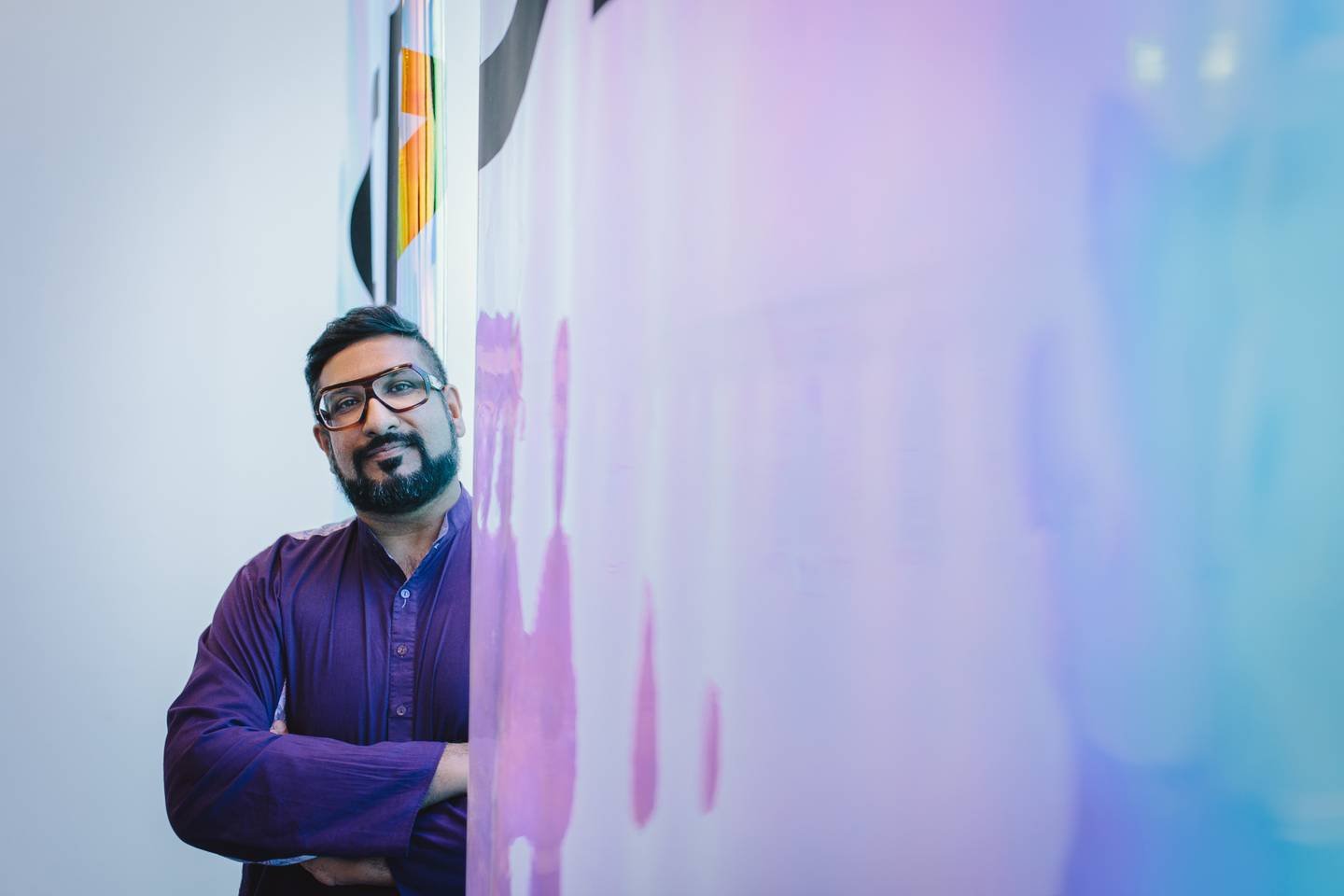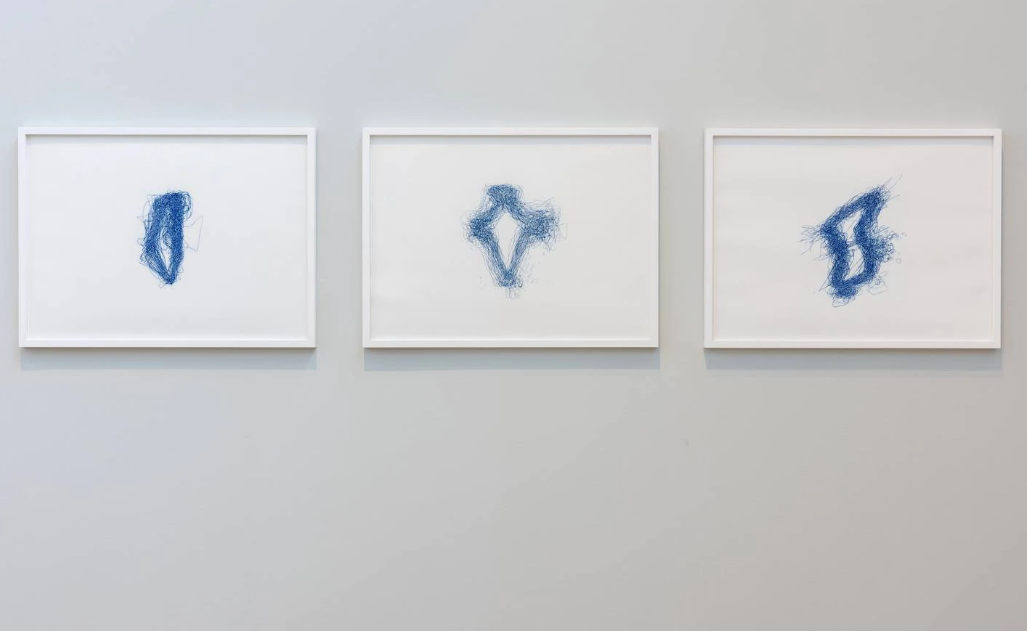The National News : New Dubai exhibition asks how the Partition of India should be commemorated (by Melissa Gronlund)
Proposals for a Memorial to Partition opens ahead of the 75th anniversary of the creation of Pakistan.
Faiza Hasan drew images from her grandmother's photos of Partition. Here, Hijr, 2022. Photo: GALLERYSKE / Art Jameel.
The show at Jameel Arts Centre commemorating the 75th anniversary of the partition of India goes as far as it can to question its own principles. What is the meaning of commemoration? Can we can consider the partition to be one event, instead of one, long extended cleaving, re-performed at every border crossing between India and Pakistan?
It manages to offer some answers along with something tangible in return: a series of texts, sketches, photographs and installations that calmly and evenly reassess the past.
Proposals for a Memorial to Partition comes with a hefty backstory — 11 years ago, curator Murtaza Vali produced a small book for the Sharjah Biennial, titled Manual for Treason. As part of this project, he invited six artists, including Fahd Burki, Nalini Malani and Seher Shah, to offer ways to collectively think through the creation of India and Pakistan and the violence and upheaval that accompanied it.
At the time, says Vali, there were no national monuments or memorials to the partition, not in India nor Pakistan.
“There was no way one could reflect or remember or mourn the tragedy that is associated with the formation of the nation state,” says Vali, who was born and brought up in Sharjah.
Murtaza Vali, the curator of Proposals for a Monument to Partition at the Jameel Arts Centre. Courtesy Art Jameel
Since then, the context in South Asia changed, with different monuments, museums and exhibitions publicly allowing a framework of remembering. In 2017, a Partition Museum opened in Amritsar in India, and the National History Museum in Lahore displayed the works of the Citizens Archive of Pakistan, which collects oral accounts of the event.
The discursive context around memorials has also changed internationally, via protest movements such as Rhodes Must Fall in South Africa and the UK and Black Lives Matter in the US.
The mismatch is visible: on the one side are histories whose colonial and racist underpinnings are in the process of being addressed, and on the other, are the set-in-stone commemorations of figures who symbolise the very worst of these pasts— such as Cecil Rhodes or Confederate generals in the US South.
“Rhodes Must Fall made me think of ideas around monuments and memorials, what sorts of histories they carry, and how to challenge them as projections of power,” Vali says.
“I wanted to think of the ways in which alternatives may be envisioned beyond just iconoclasm. How can we think of more generative ways of commemorating history?”
In this new context, the idea of proposals made more sense than ever: their temporariness suits a moment of evolution and change. This seemed particularly important in the case of the partition. The curator also wanted to work with young artists, testing how the event sat with those for whom the partition is second-hand history.
The exhibition commemorates the 75th anniversary of the partition of India. Photo: Art Jameel
“Proposals were, for me, a way of diffusing the weight of addressing this traumatic moment,” he says. “The artists feel the burden of history, of politics. The idea of proposals was to alleviate some of that.
“I've always been drawn to minor works, like sketches or drawings,” he says. “The proposal format was meant to showcase that register of work, where the artwork is part of the process and not necessarily the final, refined product.”
The works at Jameel Arts Centre that result from this long genesis do not exactly feel propositional — it is hard to differentiate between propositional and just unfinished, to be honest — but rather elongated, as if they enfold their research into the work, or show movement through time.
Parodies of binaries remain a leitmotif: Sreshta Rit Premnath offers with a succinct, cutting text work which tweaks words to turn them into imagined opposites, such as “Nation/Notion” or “Patriot/Rioter”. The show's artworks address Pakistan and India, as well as the idea of the border more generally, and underline a sense of time passing. The artists document ways of living with change, rather than attempts to freeze it.
One of the richest works is Bani Abidi’s Mothers Lands (2022), in which the Pakistani artist plays the older versions of the Indian and Pakistani women in her well-known Mangoes of 2000. In this earlier video, Abidi takes on the role of an Indian and a Pakistani, sitting side by side, comparing memories of eating mangoes while subtly competing about the number and quality of varietals in each country.
The absurdity of the two Abidis, with their similar accents, looks, and mango-eating styles, demonstrates the obvious connection between the two countries, and the arbitrariness of the idea of fundamental difference that took hold after 1947.
At Jameel, Mangoes plays alongside Mothers Lands, in which the two Abidis sit on either ends of a sofa — both urban, affluent — reminiscing about the birthday parties each threw for their sons when they were younger. The parody of separation remains the same, but the nostalgia is new: Abidi, with grey-streaked hair, twists the memories of motherhood into golden-eyed reflections of needs wanted and met, a past perhaps as embellished as a nationalism that hinges on mango varietals.
Shilpa Gupta’s 100 hand-drawn maps, part of Vali's initial project and its latest iteration. Photo by Daniella Bapista / Art Jameel
Some of the artists return from the first iteration of the project. Mumbai artist Shilpa Gupta shows different works from the series 100 hand-drawn maps of my country that she has been making since 2008, and which she contributed to Manual for Treason.
In the works she initially exhibited, she asked friends and other Mumbai residents to hand draw maps of the Indian city, contrasting a technical, objective vision of a site with the mapping of a place generated by lived experience. The choices from the series for the second edition of the show expands its purview, showing the determining influence of barriers in other cities beyond South Asia, such as Jaffa, Tel Aviv and Jerusalem.
Among newly made works, the sensitivity towards time extends into method. Young Dubai artist Nabla Yahya, for example, exhibits reproductions of objects relating to the disputed region of Kashmir that are in international museum collections (Silsila, 2022). Her medium for the work is cyanotype, a type of photography made by the long exposure of chemicals on paper to the sun.
Vali’s decision to work with younger artists also reveals the generational shift in thinking about the partition. Broadly speaking, he says, the generation that grew up after the event did not want to look back — they were involved in the nation-building exercise that accompanied the start of modern Pakistan and India. But younger people from the two countries have started to research their grandparents’ archives, seeking to understand the trauma at the heart of the two countries.
Faiza Hasan, from Hyderabad, salvaged images from her maternal grandmother’s archives and carefully replicates them in charcoal. Her grandmother had been getting rid of her old photos ahead of a house move; some of the images bear the traces of this method of disposal, where her grandmother ripped up the photos, decapitating some of the figures in an eerie echo of the partition's violence and its nation-state division.
Others, such as an audio work by Camp, reflect on the new museum articulations of partition that arose since the first show. Members of the collective surreptitiously recorded the audio guide of the Amritsar Partition Museum, editing it into an audio work that plays for visitors at Jameel.
The decision to open up the show beyond India and Pakistan demonstrates the importance of the border as a subject, though this move adds a further layer to what is already a dense project. Fortunately, many of the 18 artists and collectives touch in some way on one, important register, which bridges them despite their ostensible subject of division: the ecological crisis.
Omer Wasim's To Root, to Exist: Proposal for a Cross Border Collection of Seeds, 2022, documenting the vegetation that lives across the India/Pakistan border. Photo: Art Jameel
Nature as a protagonist weighs in strongly, often displacing other subjects.
Saira Ansari, in a gorgeous piece of creative writing, and the collective Forest Curriculum, in a not entirely successful presentation of bespoke garments, focuses on the impenetrable forest as uniting the region, as if an act of deliberate political contestation of biology that eludes human manipulation.
Similarly, Omer Wasim looks at the India-Pakistan border via images of plants that grow across the imaginary line in the dusty, dry landscape. The note here, of ecological precarity, is not one backwards to the partition or artistic responses to the subject, but a glance towards the uncertain future, as the heat waves that gripped South Asia a few months ago continues its march across the planet.
Article published on https://www.thenationalnews.com





